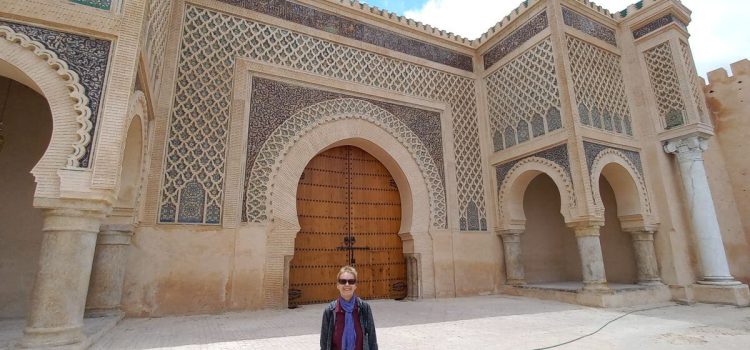
For our first eight days in Morocco, we did something a bit unusual for us; we joined a small group tour with Intrepid Travel. We were attracted by their itinerary that included all of the hotels and logistics for visiting six places in northern Morocco and then ending up in Marrakech which we really wanted to see. We also liked the idea of having a local guide with us to provide some in-depth information. So, on our first evening we assembled in our Casablanca hotel and met the rest of our group of 13 travellers from Australia, the United States, the UK, and we two Canadians. Despite an age range of greater than 50 years, it proved to be an extremely amiable group. Having met our fellow travellers, we then headed out for dinner. Check out our “Welcome to Morocco” video of mint tea being served the Moroccan way!
The next morning we embarked on our trip by train, bus, petits taxis, grands taxis (yes, they are two different things!), and even donkeys (at least for the luggage). Our photos and accompanying descriptions are divided up into these sections:
- Casablanca to Tangier, then on to Chefchaouen
- Chefchaouen
- Moulay Idriss
- Volubilis and Meknes
- Fes
- Marrakech
Casablanca to Tangier, then on to Chefchaouen
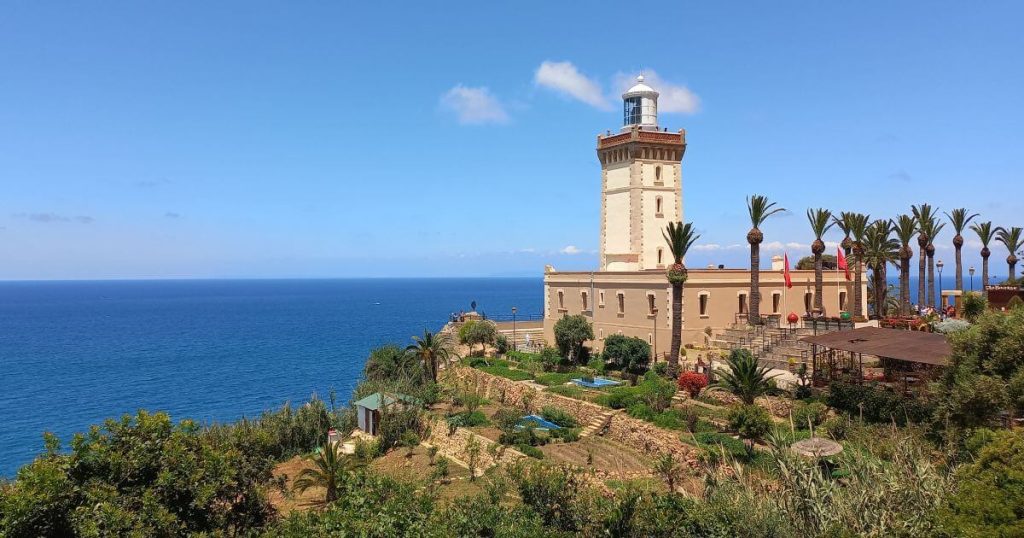
We began Day 2 of our adventure with Intrepid by walking across the street from our hotel to the train station to catch a high speed rail link to Tangier. Tangier was scenic, although without any major sights. In our brief afternoon stopover, we managed to do a picnic in the park, walk through the small medina, see a lighthouse and the “meeting of the seas”, and stop at the supposed Caves of Hercules (which one would think would have been a lot closer to Greece!). In our images below, there isn’t a picture of the meeting point of the Atlantic and the Mediterranean. The water is all the same colour and there’s no visible line in the ocean, so just the signpost in our photos.
We left Tangier by bus in the late afternoon and headed for Chefchaouen in the Rif Mountains. The drive got gradually steeper and we passed several reservoirs, not used for hydroelectric power but for seasonal irrigation for Morocco’s important agricultural products.
Chefchaouen
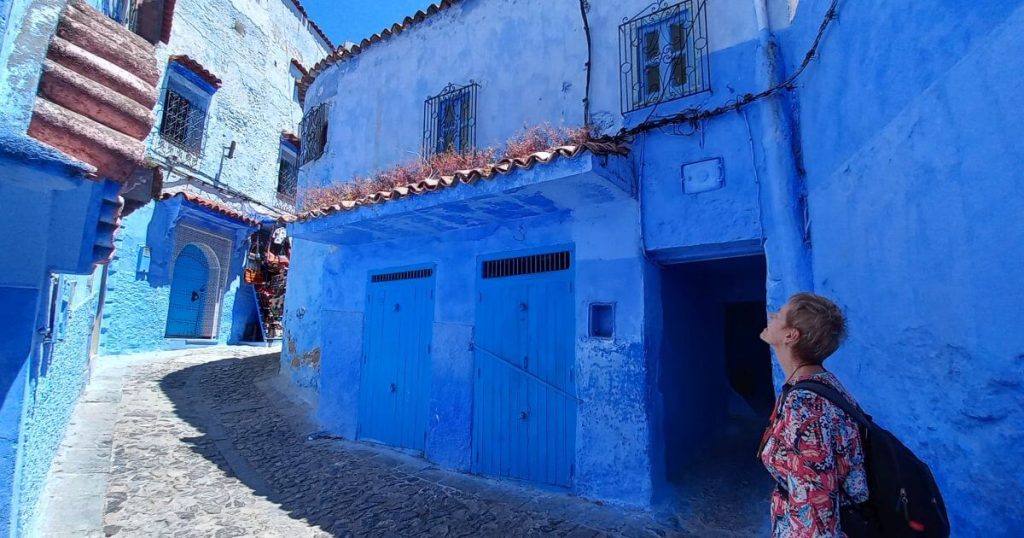
We have included a couple of photos from the end of Day 2 in our Chefchaouen collection since we arrived in “The Blue City” in the perfect light to capture the tunnel-like blue stairways and arches. We also included a shot of the garden of the restaurant where we dined that evening; our best meal since arriving in Africa three weeks earlier. Despite the promise from Google, the El Cielo restaurant did NOT have wine or beer, so we wound our way back down the blue alleyways to find Chefchaouen’s only bar. It was so smoky, dingy and seedy that we didn’t even stay, just grabbed a couple of take-away beers from the equally sketchy bottle shop attached and called it a night.
We had the entire Day 3 to look around the sights of The Blue City on our own. First up was the town’s only real tourist sight; the old kasbah (fortress) with its small ethnographic museum and views from the tower. Aside from that, we spent the day wandering the streets in all the varying shades of blue and checking out all the stuff for sale from the street vendors. One interesting stop was the community oven where every household could drop off their loaves of bread ready for baking and come back for their own freshly baked bread an hour later. We had our own freshly made street food for lunch. If you have 3 minutes you can watch our crepe being made and filled for us on YouTube. Not sure how traditional a Nutella and banana crepe is in Chefchaouen, but it was tasty!
In the evening, the Intrepid group reconvened and we hiked up to the Spanish Mosque for a view of the sunset. About 1,000 other tourists had the same idea, but admittedly the views of the sun setting behind the Rif Mountains were spectacular.
We had a couple of hours the following morning for further exploration of Chefchaouen but we kind of maxed out on the number of blue alleys and doors that we could photograph! We left the Blue City with only one disappointment; it took more than 24 hours for anyone to offer to sell us the region’s most famous agricultural product, hash. It must be that a couple of senior citizens aren’t the target market!
Moulay Idriss
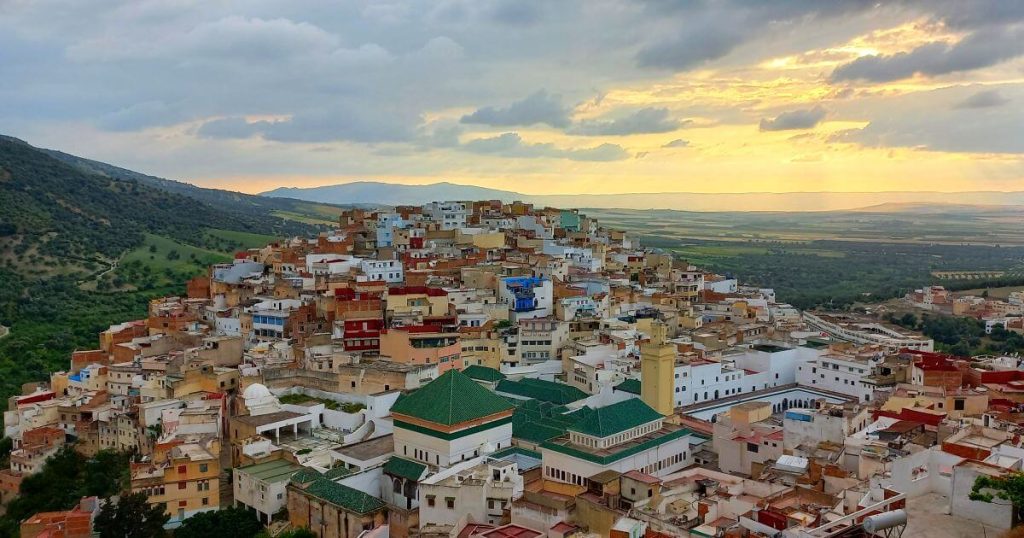
On the morning of our fourth day, we headed off towards the town of Moulay Idriss Zerhoun (or just Moulay Idriss, or just Zerhoun, to maximize confusion). Founded by Moulay Idriss after a brief stop in Volubilis (see below) to conquer a few local tribes and spread Islam at sword point. He only ruled for a few years, but he had the town named after himself and there a big zawiya (a religious complex including his mausoleum, a mosque, and other amenities).
The town is on a step hill and still has the narrow streets from the 900s, so upon arrival our luggage went up the hill to our homestay by donkey. The huge 4-storey house in which our homestay was located was a multi-generational home plus guest rooms here, there and everywhere. We settled in and then went out for a quick tour of the sights of the town. Or rather the sight of the town, the zawiya of Moulay Idriss, which wasn’t much to see since it’s not open to non-Moslems. All that we could do was lean on the wooden rail and look down the entrance. And then, after climbing to the very top of the town we could see the green tiled roof of the complex (with another nice sunset behind the town).
Upon descending to the main square there was lots of activity and music with hundreds of people milling around. We thought that it was a wedding, but it turns out that it was a circumcision ceremony with the guest of honour and his father on horseback surrounded by well-wishers. (One assumes that the horseback ride was before the main event!)
After our tour, it was time for a home cooked meal then off to bed.
Volubilis and Meknes
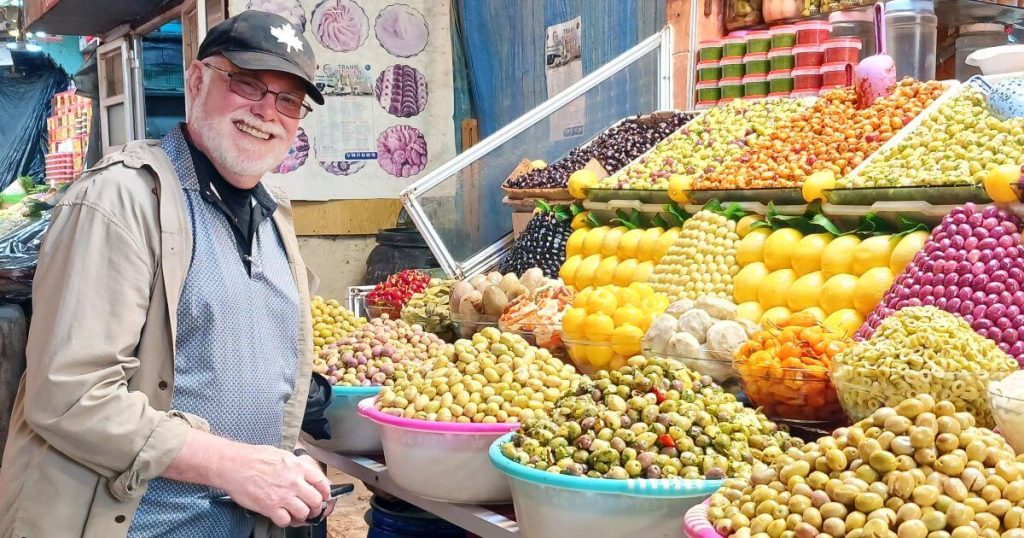
To start Day 5 of our adventure, we followed our luggage-laden donkeys back down the hill to cram into tiny taxis for the 5 km drive to the UNESCO world heritage site of Volubilis. This site was inscribed on the UNESCO list as a perfect example of a Roman town on the fringes of the empire. Of course, before it was Roman it was a Berber site (possibly even the capital of Mauretania), and after the fall of the empire it was retaken by Berber tribes, then briefly Arabian before Moulay Idriss moved to his eponymous town. By about 1,000 years ago it was completely abandoned and gradually buried until the French came along and excavated about half the Roman site in the early 1900s.
Unfortunately, everything standing on the site is a reconstruction, all the sculptures and many of the mosaics have been moved to museums off site, and the weeds are slowly reclaiming the area. Frankly, it’s a bit of a mystery why it’s a UNESCO site. Nonetheless, it was interesting to see the huge size of some of the houses featuring their own baths and a private olive press along with hot tub sized cisterns to hold the oil. It was easy to see why Volubilis was (and still is) a prosperous farming area.
Still in our clown car taxis, we drove on to Meknes (with a brief lunch stop). We were told that the ruins of Volubilis were usd as a quarry for building the new capital at Meknes. We had only a couple of hours to see Meknes on our own, so we wasted no time entering through Bab Mansour (a “bab” is a gate), crossing the main square of Place Hedim, and diving into the market and the souks. We could have visited medrasas (Islamic educational institutions), museums, and even the mausoleum of Moulay Idriss II, but instead we went on a hunt for a damascene (damasquinerie in French) workshop. Damascene is an art form in which an artisan hammers silver wire (or other metals) into grooves hand scribed in an iron base. We found one of the workshops and even bought a small piece. Check out the artisan, Ezzouak Abdelhak, at work in the YouTube video below.
In the late afternoon, we taxied onward to Fes but there are no pictures below since all that we did was go to our hotel in the new city and enjoy a dinner with our tour group.
Fes
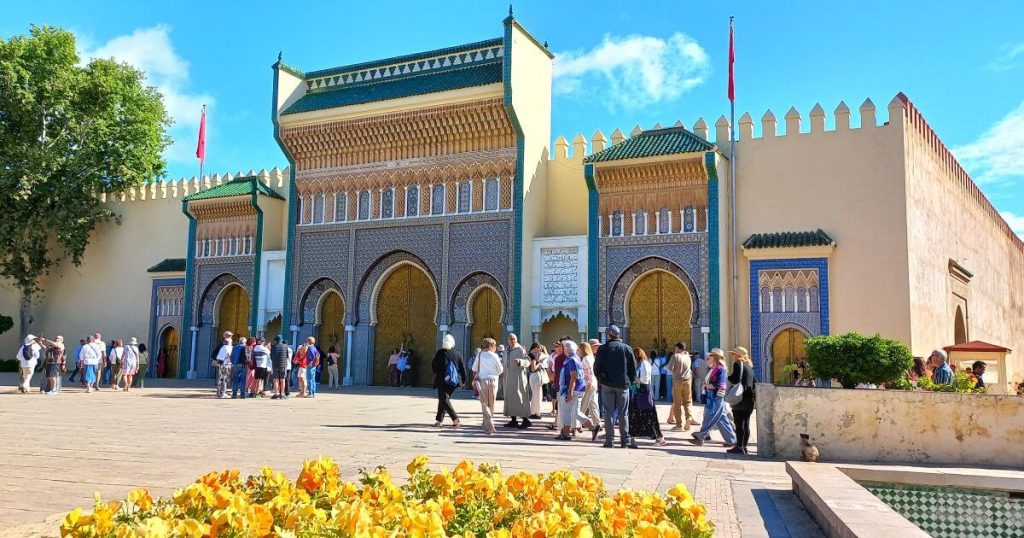
Our sixth tour day was a full day in our second royal city of the trip. Our first stop was the gates to the Royal Palace (still in use by the current king, so not open to random visitors!), right across from the former Jewish quarter. We then went up to the South Fort for a nice overview of the UNESCO listed Fes medina directly below.
Unfortunately, the balance of the day was somewhat of a disappointment as our local tour guide was intent on taking us to places outside the medina (a ceramics factory), and to shopping stops within the medina rather than to the famous gates, medrasas, and souks. To be fair, we did see some of the very narrowest and hidden of the medina’s ~9,000 streets (“one of the world’s largest car-free urban areas”) and a couple of architectural gems:
- Al Attarine Madrasa
- Funduq al-Najjarin
- a peek in the door of the Al Quaraouiyine mosque (attached to oldest university in the world)
- Seffarine Square
As far as artisan crafts go, the Chouara Tannery was a real highlight, although incredibly smelly! Good thing that the lunch stop came after the nauseating odour of the tannery.
We wrapped up the day at a fabric and garments store, which most of the men on the tour chose to sit out. After a return to the hotel for a short rest, it was time for dinner and bed.
Marrakech
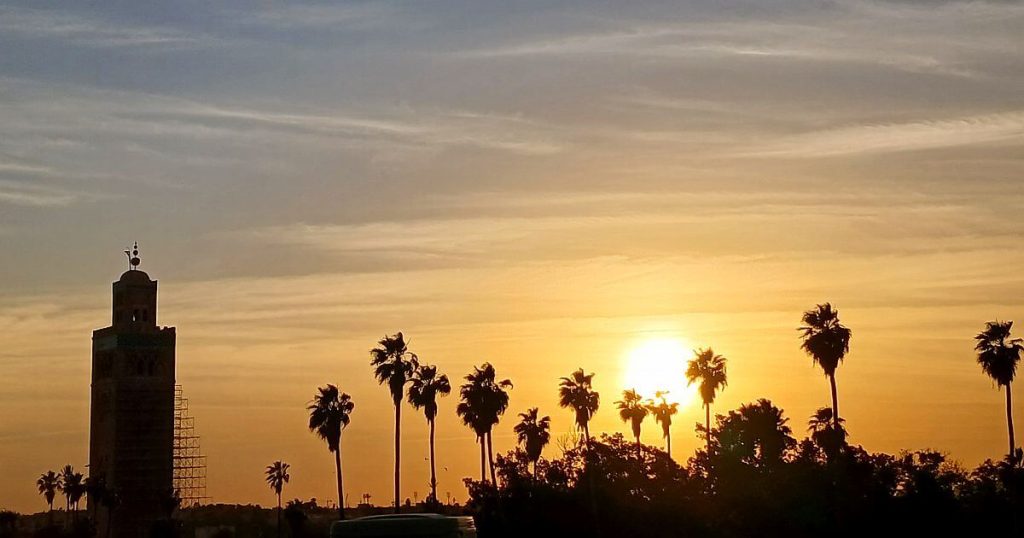
On our last full day of our Intrepid tour, we left Fes by train and headed for Marrakech. It was a train ride of over six hours, so our introduction to Marrakech was necessarily short and sweet. We saw the the Koutoubia Mosque then dove into the medina for the sights and sounds. There was a stop for Arabian sand coffee (see the video below if you don’t know what that is), and then a talk (aka sales pitch) from a traditional herbalist. Apparently all the various Moroccan herbs and spices could cure just about any ailment known to man; the talk was certainly a surefire cure for insomnia!
Emerging from the medina, we crossed the huge square of Djemaa el Fna for a final dinner with our tour group. Inevitably (or so it seemed) there was a beautiful sunset view, this time behind the minaret of the Koutoubia Mosque.































































